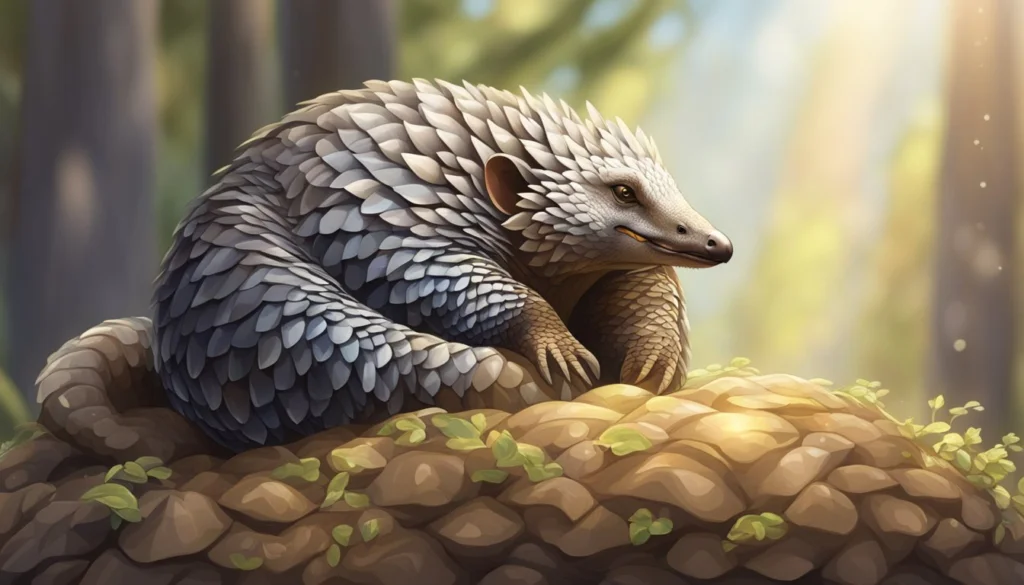Pangolins, sometimes referred to as “scaly anteaters,” are unique and fascinating creatures that play a crucial role in their ecosystems. However, despite their ecological importance, they are often overlooked—and tragically, they are also the most trafficked mammals in the world. With their distinctive scales and elusive nature, pangolins are frequently targeted for illegal wildlife trade. Here are some key facts about these incredible but endangered animals.
1. The Only Mammals with Scales
One of the most striking features of the pangolin is its tough, armor-like scales. These scales are made of keratin, the same protein found in human hair and nails, and cover nearly their entire body. These scales offer protection against predators, and when threatened, pangolins roll into a tight ball, using their scales as a shield.
Unfortunately, the very scales that protect them in the wild have made pangolins a target for poachers. In traditional medicine, particularly in parts of Asia and Africa, pangolin scales are falsely believed to have healing properties, which has fueled demand for them in illegal markets.
Unique Features:
- Scales: Made of keratin, covering the body for protection.
- Self-Defense: Rolls into a ball to shield itself from predators.
- Illegal Demand: Scales are sought after for use in traditional medicine.
2. There Are Eight Species of Pangolins
Pangolins are divided into eight species, with four species found in Africa and four in Asia. Despite being spread across two continents, all species share similar traits, such as their scale-covered bodies, long tongues, and specialized diets.
The eight species include the Indian Pangolin (Manis crassicaudata), the Chinese Pangolin (Manis pentadactyla), the Sunda Pangolin (Manis javanica), and the Philippine Pangolin (Manis culionensis) in Asia, as well as the Cape Pangolin (Smutsia temminckii), White-Bellied Pangolin (Phataginus tricuspis), Black-Bellied Pangolin (Phataginus tetradactyla), and Giant Ground Pangolin (Smutsia gigantea) in Africa.
Each species is adapted to its environment, whether it’s living in forests, savannas, or grasslands. Some species are arboreal (tree-dwelling), while others are terrestrial, spending most of their time on the ground.
Species Overview:
- 8 Species: Four in Africa, four in Asia.
- Different Habitats: Adapted to forests, savannas, or grasslands.
- Varied Behavior: Some species live in trees, while others live on the ground.
3. Specialized Diet of Ants and Termites
Pangolins are insectivores, meaning they primarily eat ants and termites. They are equipped with several adaptations that make them expert hunters of these small insects. For instance, pangolins have long, sticky tongues that can extend up to 16 inches, allowing them to reach deep into ant nests and termite mounds to capture their prey.
Interestingly, pangolins don’t have teeth. Instead, they rely on small stones and keratinous spines in their stomachs to grind up their food. This adaptation is perfect for their insect diet, which is rich in protein but requires efficient digestion.
Diet and Feeding Adaptations:
- Insectivores: Eat ants, termites, and other insects.
- Long Tongue: Can extend up to 16 inches to capture prey.
- No Teeth: Use spines and stones in their stomachs to grind food.
4. Pangolins Play an Important Role in Ecosystems
Despite their small size and specialized diet, pangolins play a crucial role in maintaining the health of their ecosystems. By eating vast amounts of ants and termites, they help control insect populations that would otherwise damage vegetation or structures.
A single pangolin can consume up to 70 million insects in a year, making them essential for balancing ecosystems. By aerating the soil while digging for food, pangolins also contribute to the health of plant life. In this way, pangolins act as natural pest controllers and ecosystem engineers.
Ecological Role:
- Insect Control: Eat millions of ants and termites each year.
- Soil Aeration: Digging helps improve soil health.
- Ecosystem Impact: Contribute to the balance of insect populations.
5. Critically Endangered Due to Illegal Trafficking
Despite their ecological importance, pangolins are the most trafficked mammals in the world. The illegal trade of pangolins is primarily driven by the demand for their scales, which are used in traditional medicines, as well as their meat, which is considered a delicacy in some countries.
According to wildlife conservation organizations, millions of pangolins have been poached from the wild in the last decade alone, with over 1 million pangolins estimated to have been trafficked. All eight species of pangolins are currently listed on the International Union for Conservation of Nature (IUCN) Red List, with some species categorized as critically endangered.
To combat this, international trade of pangolins has been banned under the Convention on International Trade in Endangered Species of Wild Fauna and Flora (CITES). However, illegal poaching and trafficking continue to threaten their survival.
Conservation Status:
- Most Trafficked Mammal: Over 1 million pangolins poached in a decade.
- CITES Protection: International trade banned, but illegal trafficking persists.
- Endangered: All species listed on the IUCN Red List, some critically endangered.
6. Solitary and Nocturnal Behavior
Pangolins are solitary animals that are mostly active at night, making them nocturnal creatures. They spend their nights foraging for ants and termites, using their powerful claws to break open insect nests. During the day, they typically rest in burrows or hollow trees, depending on their habitat.
Being solitary, pangolins usually only come together to mate. After mating, the female gives birth to one offspring, which stays with her for several months before becoming independent. Pangolin mothers are known to carry their young on their backs or tails while they forage.
Behavior:
- Solitary: Live alone except during mating.
- Nocturnal: Active at night, foraging for insects.
- Maternal Care: Mothers carry their young on their back or tail.
7. Conservation Efforts and Public Awareness
Due to their endangered status, several conservation organizations are working to protect pangolins from extinction. Anti-poaching patrols, stricter enforcement of wildlife trafficking laws, and public awareness campaigns are all crucial efforts in safeguarding these animals.
Public awareness is key to reducing the demand for pangolin products in traditional medicine and illegal markets. Many people are unaware of the pangolin’s plight, but conservation groups are actively educating communities about the importance of protecting these animals. Increasing awareness about the role of pangolins in the ecosystem and the threats they face is crucial to their survival.
Conservation Efforts:
- Anti-Poaching Patrols: Protecting pangolins in the wild.
- Education Campaigns: Raising awareness about the illegal trade and ecological importance.
- Laws and Enforcement: Stricter wildlife trafficking laws to protect pangolins.
Conclusion
Pangolins are remarkable creatures that deserve much more attention and protection than they currently receive. Their unique adaptations, including their armored scales, long tongues, and crucial role in pest control, make them vital to their ecosystems. However, their status as the most trafficked mammal in the world has put all eight species in grave danger. By supporting conservation efforts and raising awareness about their plight, we can help ensure that these incredible animals continue to thrive in the wild.
FAQ
What are pangolin scales made of?
Pangolin scales are made of keratin, the same material found in human hair and nails.
Why are pangolins trafficked?
Pangolins are trafficked for their scales, which are falsely believed to have medicinal properties, and for their meat, which is considered a delicacy in some cultures.
How many species of pangolins are there?
There are eight species of pangolins, with four found in Africa and four in Asia.
Are pangolins endangered?
Yes, all eight species of pangolins are listed on the IUCN Red List, with some species considered critically endangered due to poaching and illegal trafficking.
How do pangolins protect themselves from predators?
Pangolins roll into a tight ball when threatened, using their tough scales as armor to protect themselves from predators.
What can be done to protect pangolins?
Supporting conservation efforts, enforcing wildlife trafficking laws, and raising public awareness about the illegal trade in pangolins are key steps in protecting them from extinction.


